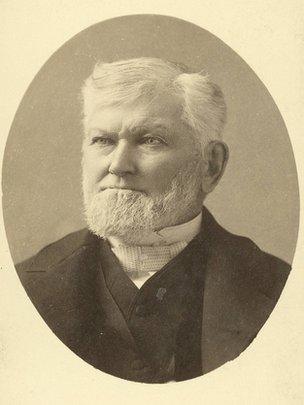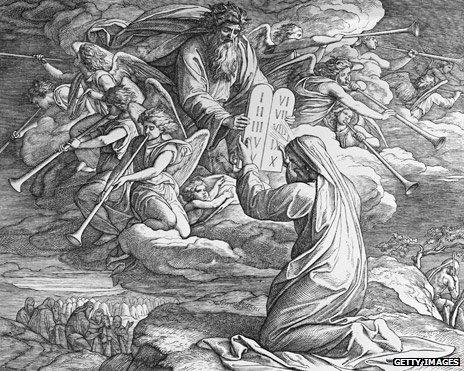How religions change their mind
- Published

Once upon a time, animal sacrifice was an important part of Hindu life, Catholic priests weren't celibate and visual depictions of the Prophet Muhammad were part of Islamic art. And soon some churches in the UK may be marrying gay couples. How do religions manage to change their mind?
In 1889, Wilford Woodruff became the fourth president of the Church of Jesus Christ of Latter-Day Saints - more commonly known as the Mormon Church.
As president, he was seen as a living prophet, someone who could receive wisdom and advice from Jesus Christ. And he was certainly in need of advice - his church was in crisis.
For 40 years, Mormons had been at loggerheads with the US Congress over the issue of polygamy, which was encouraged among male believers. The government said it was illegal, and held that religious conviction was no defence.

Woodruff in 1889 - he had seven wives across his life, and 33 children
Woodruff and others lived a precarious life, moving around in an attempt to dodge marshals with arrest warrants for bigamy. In 1890, the government brought things to a head by moving to confiscate all of the church's assets.
It was then, Woodruff said, that Jesus Christ appeared to him in a vision and showed him the future of the Mormon Church if the practice wasn't stopped - and it wasn't pretty. Although he did not renounce plural marriage, he issued a manifesto banning it.
If that sounds like a problem easily solved, it wasn't - according to Kathleen Flake, a professor in American religious history at Vanderbilt University, and a Mormon herself.
"It was a very difficult thing socially, personally and theologically," she says. The change destabilised the entire church, and led to deep reflection about what Mormonism's core principles were.
History shows that any religion that refuses to change dies out, Flake adds. But what about those religions that don't have living prophets - how do they change?
For Muslims, the last prophet, the Prophet Muhammad, died almost 1,400 years ago. So it's the ulama, a class of legal scholars, who rule on contentious points of Islamic or sharia law based upon a careful scrutiny of fundamental sacred texts, including the Koran and the Sunnah, a collection of stories relating the beliefs and practices of Muhammad.
An obvious challenge here is how specific laws governing life in 7th Century Arabia can be applied across the world in the 21st Century. Perhaps it's no surprise that the ulama in different countries make different judgements, and sometimes change their mind.
A century ago, using a radio or loudspeaker was haraam - forbidden. Today, many observant Muslims have their own radio, TV and even YouTube channels.
Similarly, at the time of the Iranian revolution in 1979, the ulama there said that birth control was haraam, but now the use of condoms is encouraged, with state-supported condom factories and pre-marital family planning lessons.
"The assumption was that anything from the West was going to undermine Islam," says Muqtedar Khan of the University of Delaware.
And quite often, he says, there is a tension between aspects of Western daily life and Muslim teachings. One challenge for Muslim men, for example, is the urinal.
"One of the traditions for Muslim men is to sit and pee," Khan says, explaining that this was thought to be the best way of preventing spillage that would defile devotees' clothes before prayers. This is not always possible in the urinal-loving West.
Another challenge is the architecture of Western homes.
"These houses that are designed in the West have no gender segregation. If you're having a Muslim-only party and then you have women who want segregation, then it is very complicated," he says, adding that he missed three or four of his son's birthday parties as a result.
Sometimes Muslims in multicultural societies long for scriptures to be reinterpreted, Khan says.
Clerics faced with these decisions have a choice between a literal interpretation of the Koran, or attempting to look beneath the surface for a deeper message.
The key, according to Tariq Ramadan of Oxford University is to distinguish "principles" that are immutable and "models" that are a product of the time and place the stories were told. From this perspective, changing our inferences from the Koran is not just an option but an obligation.
"There is no faithfulness to the message of Islam without evolution in our understanding," he says.
So, while there is a verse of the Koran which appears to permit beating a woman, "the best example was the Messenger himself never beating a woman," Ramadan says.
Arvind Sharma, a professor of Comparative Religion at McGill University, relates an incident which seems to show how it's possible to update models at the same time as underscoring the principles that form a religion's continuity. His anecdote centres on the moment Mahatma Gandhi discussed the principle of karma - the Hindu doctrine that you will pay for your actions, or be rewarded for them, perhaps in a future life.
"Karma was used to justify untouchability in classical Hinduism," says Sharma. "A person is born an untouchable because in a previous life he performed certain foul deeds, so he should accept the status quo as it is."
Sharma says Gandhi pointed out that all castes of Hindus had been treated as untouchable by the British in India, who would post signs outside their clubs saying "Dogs and Indians not allowed".
"Gandhi's argument was: 'You see how karma works? You treated people as untouchable on the basis of their birth, and you have also been treated as untouchables on the basis of your birth.'" In criticising Indians' traditional interpretation of karma - and showing how they were paying for their poor treatment of untouchables - Gandhi was at the same time invoking and restating the principle of karma.
A famous story from the Talmud, one of the Jewish holy books, seems to foresee that future generations will interpret holy law in their own way.

A mid-19th C engraving of Moses receiving the 10 commandments on Mt Sinai
In the story, Moses goes to Mt Sinai to receive the Torah - another Jewish holy book - from God. Moses spots God embellishing the letters with little crowns.
"Moses, who was a humble man, says 'Well, really you know, I'll take it plain,'" relates Rabbi Burt Visotzky from the Jewish Theological Seminary in New York.
"And God says: 'No - many generations from now there will be a rabbi by the name of Akiva, and he will actually derive Jewish law from the very crownlets on the letters.'"
When God shows Moses a vision of Rabbi Akiva teaching, Moses is dismayed because he can't understand anything.
"Built within the Talmud itself - that repository of great law and wisdom of the rabbis - is a notion that things change but it's still all part of revelation," says Visotzky.
One of the forces exerting pressure on religion to change is science. The Copernican Revolution - when scholars grasped that the earth revolves around the sun, rather than vice-versa - is an obvious example.
This clashed with the church's own teaching on the subject. The Inquisition found Copernicus's successor Galileo "vehemently suspect of heresy" and he spent the last decade of his life under house arrest.
As well as his works on physics and astronomy Galileo wrote two tracts on the interpretation of scripture.
"He essentially said the scriptures were written to tell us how to go to heaven and not how the heavens go," says George Coyne, a Jesuit priest who ran the Vatican's own observatory for 28 years.
The Catholic church now admits that Galileo was right and in 1992 Pope John Paul II formally exonerated him. But science continues to raise difficult questions for the church.
"The whole area of genetics, molecular biology and evolution in general are quite a challenge to the church," says Coyne. "Does the ghost of Galileo come back to speak? Yes it does. My loving church! What you did in the Galileo period was not listen to science."
For Coyne, it is the role of scientifically trained believers to throw themselves into the muddy, difficult process of squaring the church's teachings with the discoveries of science and the opportunities they offer for humanity.
The question of what to believe - or who to believe - falls, in the end, to believers rather than teachers.
"We ultimately have to make that creative effort to think for ourselves and puzzle things out for ourselves," says Karen Armstrong, the author of a History of God, and more than 20 other works in religious studies.
While the answer to the question of how to live might be found using scripture, it won't be in scripture, she says, just as the ability to drive is not found in a car manual.
But she admits that this is hard for those people who, in a world of rapid change, look to their religion for something steady and fixed - an easy-to-access pot of answers.
"People often think religion is easy," says Armstrong. "In fact it requires a great deal of intellectual, spiritual and imaginative effort. It's a struggle that never ceases."
You can listen to Heart and Soul on the BBC World Service. Listen back to the two-part series Absolving the Past via iplayer or browse the Heart and Soul podcast archive.
You can follow the Magazine on Twitter , externaland on Facebook, external.